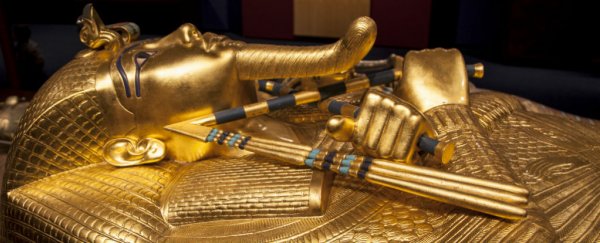The tomb of the famous boy king, Tutankhamun, could contain two secret chambers, Egypt's antiquities minister announced today, and archaeologists suspect that his long-lost stepmother, Queen Nefertiti, could be buried inside.
The discovery was thanks to new high-resolution images that were taken of the northern and western internal walls of the 3,300-year-old tomb. When archaeologists zoomed right in on the details, they found markings in the plaster that were oddly similar to those found by Howard Carter on the entrance gate of King Tut's tomb in 1922.
The photographs "revealed several very interesting features which look not at all natural," Minister Mamdouh el-Damaty told the press. "Features like very, very straight lines which are 90 degrees to the ground, positioned so as to correspond with other features within the tomb."
He added that they were near-impossible to spot with the naked eye, hence why it took researchers so long to find them.
Speaking with Nicholas Reeves, a British Egyptologist from the University of Arizona who took the photographs, el-Damaty said a popular theory is that when King Tutankhamun died unexpectedly in 1323 BC at just 19 years old, his body was rushed into a new burial chamber that was essentially 'tacked onto' the side of his step-mother, Queen Nefertiti's, tomb.
Support for this theory comes from the fact that the design of King Tut's tomb appears to be more suited to a queen than a king, Reeves says.
Rossella Lorenzi explains at Discovery News:
"He argued that a painting located behind King Tut's sarcophagus has been wrongly interpreted. The painting shows Ay (who largely directed King Tut's reign and succeeded him) performing the Opening of the Mouth ritual on the boy king. The figure labelled Tutankhamun would actually be Nefertiti. He noted that the lines at the corner of the figure's mouth are a trademark in pictures of Nefertiti. On the other hand, the figure labelled Ay would be Tutankhamun, completing the death ritual for Nefertiti."
While el-Damaty says he agrees with Reeves that someone is likely buried in those secret chambers, he doesn't think they'll find the much-sought-after body of Nefertiti. "The theory is a very good theory but it doesn't mean it's true. The best theories don't always work," he told reporters. The antiquities minister thinks it's more likely that a woman named Kia, hypothesised to be Tutankhamun's biological mother, lies within.
El-Damaty told reporters they're in the process of seeking final approval to perform a radar inspection of the tomb, which will confirm the presence of hidden chambers. The results of the radar scans are expected to be announced on November 4.
